EnviroLite EVRH2000R-6 Guía de instalación
- Tipo
- Guía de instalación

READ ALL THE INSTRUCTIONS
TOOLS & MATERIALS REQUIRED
Before assembling your lighting fixture, refer to the “ELECTRICAL
CONNECTIONS” section. If you feel you do not have electrical wiring
experience, refer to a do-it-yourself wiring handbook or have your fixture
installed by a qualified licensed electrician.
QUESTIONS? CALL TOLL FREE
1-855-573-6156
INSTALLATION & OPERATION INSTRUCTIONS –
4” REMODEL NON-IC RECESSED LIGHTING HOUSING WITH SLIDE-N-LOC™ FEATURE
ALL RIGHTS RESERVED. COPYRIGHT ENVIROLITE 2019
Ladder, BX or NM Cable, BX Cable Connectors (if necessary), Keyhole
Saw, Flathead Screwdriver, Hammer, Insulated Pliers, Pencil, UL Listed
Electrical Tape.
MODEL EVRH2000R
CAUTION
BEFORE YOU BEGIN
1. To ensure the success of the installation, be sure to read these
instructions and review the diagrams thoroughly before beginning.
2. All electrical connections must be in accordance with local code,
ordinances. If you are unfamiliar with methods of installing electrical
wiring, secure the services of a qualified licensed electrician.
3. IMPORTANT: This fixture is Non-IC type fixture.
A Non-IC type fixture is intended for use in recessed cavities or
suspended ceilings where the recessed portions of the fixture,
other than at points of support, must be a minimum of 3” from
thermal insulation and at least 1/2” from combustible material (e.g.
ceiling joists, floor boards). (Fig. 1)
CEILING INSTALLATION
1. Choose the location for the fixture, taking into consideration the 6” depth
clearance, the location of ceiling joists and the accessibility for the
electrical supply. For Non-IC models, a 1/2” clearance from the joists and
floor boards and 3” clearance from insulation must also be considered.
Mark the selected location using the provided template.
2. Using a keyhole saw make the hole in the ceiling surface. (Fig. 2) (Note:
Be sure not to make the hole any larger than specified by the template.
An oversized hole may not allow for proper installation.)
(Note: A housing with a white-painted can is a Non-IC type fixture).
If you have determined that your housing is a Non-IC type, be sure
to space any insulation away a minimum of 3”.
4. This fixture is thermally protected. A blinking light indicates thermal
insulation has been placed too close to the fixture, or an incorrect lamp
has been installed, or heat from another source is affecting the fixture.
Always double check your intended locations prior to making holes in the
ceiling for installation.
5. This fixture is a remodel type fixture. A remodel type fixture is for
applications where there is an existing ceiling surface, such as drywall,
and the ceiling joists are not accessible. For applications where there is
no ceiling surface and the ceiling joists are accessible, such as when a
home is under new construction, a new-construction type fixture should
be used.
6. Note: This remodel type fixture uses special C-clips to secure itself to
the ceiling material. The C-clips are designed for surfaces that are
between 3/8” and 3/4” thick. These C-clips will not work on surfaces
thicker than 3/4”.
7. Before starting the installation, disconnect the power by turning off the
circuit breaker or by removing the appropriate fuse at the fuse box.
Turning the power off by using the light switch is not sufficient to prevent
electrical shock.
8. Check if the power source is suitable for the added electrical load.
Power should be supplied by a 120 volt, 60 Hz single circuit. A standard
120 volt, 15 amp branch circuit is designed to carry a maximum load of
1800 watts. We recommend that the total wattage of all the lights and
appliances, on that circuit, not exceed 80% or 1440 watts, of the
maximum electrical capacity.
UNPACK THE FIXTURE
Check the contents of the box. You should receive:
• 1 – Housing (can, junction box)
• 1 - Trim assembly (kits only)
PREPARING AND MOUNTING THE FIXTURE
NOTE: First turn off electricity at the circuit breaker or the fuse box. Turning the power
off by using a wall switch is not sufficient to prevent electrical shock.
• 1 – Template
• 3 – C-clips
Note: Hanger bars are not provided. They must be purchased separately.
Fig. 2
3. Proceed to the “ELECTRICAL CONNECTIONS” section to connect the
housing to the home / building electrical supply.
4. Attach the provided C-clips onto the inside surface of the can by inserting
the ends into the provided T-slots, as shown. Feed the junction box
through the ceiling hole, followed by the can. Allow the C-clips to hang on
the inside surface of the can until the can is completely inserted into the
ceiling. (Fig. 3)
Ceiling joist
Ceiling surface
Fig. 3
Note: The T-shaped end of the C-clip should be
inserted into the bottom part of the T-slot
3 in. (76 mm) min. gap
Side View
of Housing
Cross-section
view of C-clip
attachment to T-
slot of can
T-slot
C-clips
Can
Ceiling
Junction
Box
• 3 – “Quick-Connect”
Wire Connectors
Fig. 1

ALL RIGHTS RESERVED. COPYRIGHT ENVIROLITE 2019
When using the “quick-connect” wire connectors, be sure that there are no
loose/exposed wire strands. Wrap each wire connection using UL Listed
electrical tape.
Rectangular
Knockout
NM Cable
(ROMEX)
Junction box door
Flathead
Screwdriver
FIG. 8
“Quick-Connect”
wire connectors
1. After installing and finishing the ceiling surface, insert the trim into the
housing.
2. Screw a light bulb into the lamp socket and making sure to use the lamp
type an wattage specified on the housing’s lamp replacement label.
3. Installation is complete. Restore electrical power.
Pry out
knockout
SLIDE-N-LOC™ -
Slide NM cable
into locking slot
5. Close the junction box door until the metal latch snaps, making sure
that all wiring and wire connectors are contained within the box.
FIG. 7
Round
Knockout
NOTE: Additional lighting fixtures may be connected to the fixture’s
junction box. Several knockouts are provided on the junction box to
accommodate additional BX or NM cables intended to connect to other
fixtures. A marking on the junction box door specifies the maximum
number of wires and the maximum wire gauge that can be inserted into
the junction box.
ELECTRICAL CONNECTIONS (CONT.)
TRIM INSTALLATION
ELECTRICAL CONNECTIONS
1. Using flexible conduit or NM (Romex) cable, run the house/building
electrical wiring to recessed fixture locations.
2. Open the junction box’s door by pulling on its metal tab.
A. FOR ELECTRICAL FLEXIBLE CONDUIT - Break off the appropriate
sized round knockout using a screwdriver. Feed the conduit through the
knockout hole, using an appropriately sized connector to lock the conduit
into the junction box. Remove 3” of the conduit metal sheath and
remove the plastic or paper over-wrap. (Fig. 7)
B. FOR NM (Romex) CABLE – Bend up a rectangular tab locate on the
top of the junction box using a screwdriver. Insert the NM-B cable into
the slot until 6” of length enters the junction box. Strip 3” of the cable’s
plastic sheath and remove the paper over-wrap. (See inset of Fig. 7)
3. Strip approximately 3/8” of insulation from the ends of all supply wires.
Make the following wire connections within the junction box:
WHITE fixture wire TO WHITE (NEUTRAL) supply wire
BLACK fixture wire TO BLACK (HOT) supply wire
GREEN fixture wire TO GREEN OR BARE (GROUND) supply
wire
Be sure to use UL Listed wire connectors suitable for the size, type, and
number of conductors. Be sure that there are not any loose strands or
loose wire. Secure wire connectors with UL Listed electrical tape.
WARNING - Use supply wires rated 90°C.
4. Close the junction box’s door making sure that all wiring and wire
connectors are contained within the box. (Fig. 7)
5. Push the can complete into the ceiling until the lip of the can is flush
against the ceiling. Make sure the C-clips are still hanging on the inside
of the can. (Fig. 4)
6. Push all three ceiling clips through the T-slots until they are outside of
the can. Continue to push the clips until they snap into place. (Fig. 5)
C-clip
Fig. 4
Fig. 5
C-clip
Hand
Can
Ceiling
Ceiling
Junction
box door
Knockout
Fig. 6

LEER TODAS LAS INSTRUCCIONES
HERRAMIENTAS Y MATERIALES NECESARIOS
Antes de ensamblar tu lámpara, consulta la sección de “CONEXIONES
ELÉCTRICAS”. Si no tienes experiencia con el cableado eléctrico, consulta
un manual hazlo tu mismo sobre cableado o pídele a un electricista
calificado y certificado que instale tu lámpara.
¿PREGUNTAS? LLAMA GRATIS
AL 1-855-573-6156
INSTRUCCIONES DE INSTALACIÓN Y FUNCIONAMIENTO - CARCASA DE LUMINARIA
EMPOTRADA PARA REMODELACIÓN TIPOS IC Y NO-IC DE 6” CON FUNCIÓN SLIDE-N-LOC™
TODOS LOS DERECHOS RESERVADOS. COPYRIGHT ENVIROLITE 2019
Escalera, Cable BX o NM, Conectores de Cable BX (si es necesario),
Serrucho de Punta Fina, Destornillador de Cabeza Plana, Martillo, Alicate
Aislado, Lápiz, Cinta Aislante con clasificación UL.
PRECAUCIÓN
ANTES DE EMPEZAR
1. Para garantizar una instalación satisfactoria, asegúrate de leer estas instrucciones
y revisar los diagramas antes de empezar.
2. Todas las conexiones eléctricas deben cumplir con las ordenanzas y códigos
locales. Si no estás familiarizado con los métodos de instalación del cableado
eléctrico, contrata los servicios de un electricista certificado y calificado.
3. IMPORTANTE: Esta luminaria es un aparato de No-IC. Una luminaria de tipo
No-IC fue diseñada para ser utilizada en espacios empotrados o techos falsos
donde la parte empotrada de la luminaria, con la excepción de los puntos de
apoyo, se encuentre al menos a 3” de distancia de todo material de
aislamiento térmico y al menos 1/2” de distancia del material combustible
(p.ej. vigas del techo, tablas de piso). (Fig. 1)
INSTALACIÓN EN EL TECHO
1. Elige el lugar para la luminaria, tomando en cuenta los 6” de espacio de
profundidad necesarios, la ubicación de las vigas del techo y el acceso al
suministro eléctrico. Para los modelos de tipo No-IC, considera una distancia de
1/2” de las vigas y tablas del piso y 3” de todo aislamiento. Marca la ubicación
elegida con la plantilla incluida.
2. Usando un serrucho de punta fina, corta el orificio en el techo. (Fig. 2) (Nota:
Evita realizar un orificio más grande que lo especificado en la plantilla. Un orificio
más grande podría dificultar la instalación correcta de la luminaria).
(Nota: Una carcasa con una lata pintada de blanco es una luminaria del tipo
No-IC.) Si has determinado que tu carcasa es del tipo No-IC, asegúrate de
mantener una distancia mínima de 3” respecto a todo material de
aislamiento.
4. Esta luminaria cuenta con protección térmica. Una luz parpadeante significa que la
luminaria ha sido instalada demasiado cerca del material de aislamiento térmico,
que has instalado una bombilla incorrecta o que otra fuente de calor está
interfiriendo con la luminaria. Siempre revisa el sitio donde planeas instalar la
luminaria antes de perforar el techo.
5. Esta es una luminaria para remodelaciones. Su uso está limitado a aplicaciones
de remodelación en las que la superficie del techo ya está instalada (p.ej. placas
de yeso) y donde las vigas del techo no están expuestas. Para aplicaciones en las
que el techo no ha sido instalado y las vigas están expuestas, como en hogares
aun en construcción, se recomienda una luminaria para construcciones nuevas.
6. Nota: Esta luminaria para remodelaciones usa clips "C" especiales para sujetarse
al techo. Los clips "C" fueron diseñados para superficies de entre 3/8” y 3/4” de
grosor y no servirán para superficies mayores a 3/4”.
7. Antes de comenzar la instalación, desconecta el suministro de electricidad,
apagando el cortacircuitos o retirando el fusible en la caja de fusibles. Desconectar
la electricidad en el interruptor de la pared no será suficiente para prevenir una
descarga eléctrica.
8. Verifica que la fuente de electricidad sea adecuada para la carga eléctrica
adicional. La electricidad debe venir de un solo circuito de 120 voltios, 60 Hz. Un
circuito derivado estándar de 120 voltios y 15 amperios está diseñado para
soportar una carga máxima de 1800 vatios. Recomendamos que el vataje total de
todas las luces y electrodomésticos del circuito no exceda el 80% de la capacidad
eléctrica máxima, o 1440 vatios.
DESEMPACAR LA LUMINARIA
Revisa el contenido de la caja. Debes tener:
• 1 – Carcasa (lata, caja eléctrica)
• 1 – Moldura de la luminaria (sólo en kits)
PREPARAR E INSTALAR LA LUMINARIA
NOTA: Desconecta el suministro de electricidad en el cortacircuitos o la caja de
fusibles. Desconectar la electricidad en el interruptor de la pared no será suficiente para
prevenir una descarga eléctrica.
• 1 – Plantilla
• 3 – Clips "C"
Nota: No se incluyen barras para colgar, las cuales se venden por separado.
Fig. 2
3. Continúa con la sección “CONEXIONES ELÉCTRICAS” para conectar la carcasa al
suministro eléctrico de la casa/edificio.
4. Coloca los clips "C" provistos en la superficie interior de la lata insertando sus
extremos en las ranuras “T” provistas, según se observa en el diagrama. Pasa la
caja eléctrica por el orificio del techo, seguido de la lata. Los clips “C” deben quedar
colgando en el interior de la lata hasta que esta esté completamente insertada en el
techo. (Fig. 3)
Viga del techo
Superficie del techo
Fig. 3
Clips “C”
Lata
Vista transversal
de la fijación del
clip “C” a la ranura
“T” de la lata
Techo
Caja de
conexiones
Ranura
“T”
Vista lateral
de la carcasa
Nota: El extremo en forma de “T” del clip “C” debe
insertarse en la parte inferior de la ranura “T”
• 3 – Conectores de
Cable “Quick-Connect”
3 pulgadas (76 mm) de
espacio mínimo
Fig. 1
MODEL EVRH2000R

TODOS LOS DERECHOS RESERVADOS. COPYRIGHT ENVIROLITE 2019
Al usar los conectores de cable “quick-connect”, verifica que no haya hilos
de cable sueltos o expuestos. Envuelve cada conexión con cinta aislante
con clasificación UL.
Entrada
rectangular
Cable NM
(ROMEX)
Puerta de la caja
eléctrica
Destornillador
de cabeza
plana
FIG. 8
Conectores de
cable “Quick-
Connect”
1. Después de instalar y terminar la superficie del techo, coloca la moldura
en la carcasa.
2. Verifica que tienes una bombilla del tipo y vataje especificados en la
etiqueta de la carcasa de la lámpara; enróscala en el portabombillas de
la lámpara.
3. La instalación está terminada. Restablece el suministro de energía
eléctrica.
Abrir
entrada
SLIDE-N-LOC™ -
Desliza el cable
NM hasta la ranura
de fijación
5. Cierra la puerta de la caja eléctrica de modo que el pestillo de metal
encaje y todo el cableado y los conectores queden dentro de la caja
FIG. 7
Entrada
redonda
NOTA: Otras luminarias pueden ser conectadas a la caja eléctrica. La
caja eléctrica incluye varias entradas adicionales para cables BX o NM,
en caso de que se quieran conectar otras luminarias. La puerta de la
caja eléctrica incluye especificaciones sobre el número máximo de
cables y el calibre máximo que se puede conectar a la caja eléctrica
CONEXIONES ELÉCTRICAS (CONTINÚA)
INSTALACIÓN DE LA MOLDURA
CONEXIONES ELÉCTRICAS
1. Usando un conducto flexible o cable NM-B (Romex), lleva el cableado eléctrico de
la casa/edificio hasta las ubicaciones de las luminarias empotradas.
2. Abre la puerta de la caja eléctrica levantando el pestillo de metal.
A. PARA CONDUCTOS ELÉCTRICOS FLEXIBLES – Con un destornillador, rompe
el tapón de una de las entradas redondas. Pasa el conducto por la entrada, usando
un conector de tamaño apropiado para fijar el conducto a la caja eléctrica. Retira
3” del recubrimiento metálico del conducto y quita la envoltura de papel o plástico.
(Fig. 7)
B. PARA CABLES NM-B (Romex) – Con un destornillador, afloja el tapón de una
de las aberturas rectangulares ubicadas en la parte superior de la caja eléctrica.
Coloca el cable NM-B en la ranura hasta insertar 6” de cable en la caja eléctrica.
Retira 3” del recubrimiento plástico del cable y quita la envoltura de papel o
plástico. (Fig. 7)
3. Retira unos 3/8” de aislamiento de los extremos de todos los cables de suministro.
Realiza las siguientes conexiones en la caja eléctrica:
Cable BLANCO de la luminaria AL Cable de suministro BLANCO (NEUTRAL)
Cable NEGRO de la luminaria AL Cable de suministro NEGRO (VIVO)
Cable VERDE de la luminaria AL Cable de suministro VERDE/SIN
AISLAMIENTO (A TIERRA)
Asegúrate de usar conectores de cable con clasificación UL adecuados para el
tamaño, tipo y número de conductores. Verifica que no haya hilos o cables sueltos.
Envuelve cada conexión con cinta aislante con clasificación UL.
PRECAUCIÓN – Usa cables de suministro con clasificacion 90°C.
4. Cierra la puerta de la caja eléctrica asegurándote de que todos los cables y
conectores de cable queden dentro de la caja. (Fig. 7)
5. Inserta totalmente la lata en el techo hasta que el borde de la lata quede
a ras del techo. Verifica que los clips “C” aún estén colgando en el
interior de la lata. (Fig. 4)
6. Pasa los tres clips para techo por las ranuras “T” hasta el exterior de la
lata. Continúa empujando los clips hasta que queden encajados. (Fig. 5)
Clip "C"
Fig. 4
Fig. 5
Clip "C"
Mano
Lata
Techo
Techo
Puerta de la
caja eléctrica
Entrada
FIG. 6
-
 1
1
-
 2
2
-
 3
3
-
 4
4
EnviroLite EVRH2000R-6 Guía de instalación
- Tipo
- Guía de instalación
en otros idiomas
Artículos relacionados
Otros documentos
-
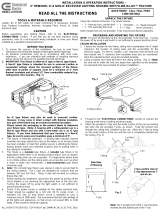 Commercial Electric CAT7ICRM Guía de instalación
Commercial Electric CAT7ICRM Guía de instalación
-
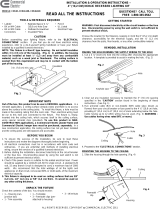 Commercial Electric CER4G24R463WHP Guía de instalación
Commercial Electric CER4G24R463WHP Guía de instalación
-
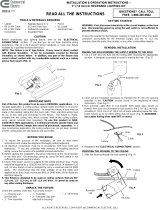 Commercial Electric CER3G10R343BNP Guía de instalación
Commercial Electric CER3G10R343BNP Guía de instalación
-
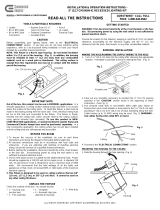 Commercial Electric CER5R532WHP Guía de instalación
Commercial Electric CER5R532WHP Guía de instalación
-
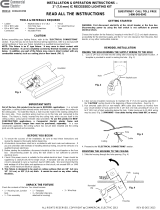 Commercial Electric CER3LICR3730WH Guía de instalación
Commercial Electric CER3LICR3730WH Guía de instalación
-
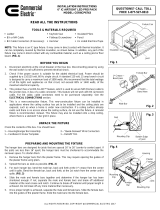 Commercial Electric CER6CP6743-4PK Guía de instalación
Commercial Electric CER6CP6743-4PK Guía de instalación
-
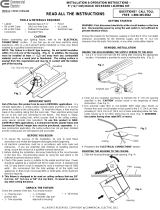 Commercial Electric CER5R532WHP Guía de instalación
Commercial Electric CER5R532WHP Guía de instalación










